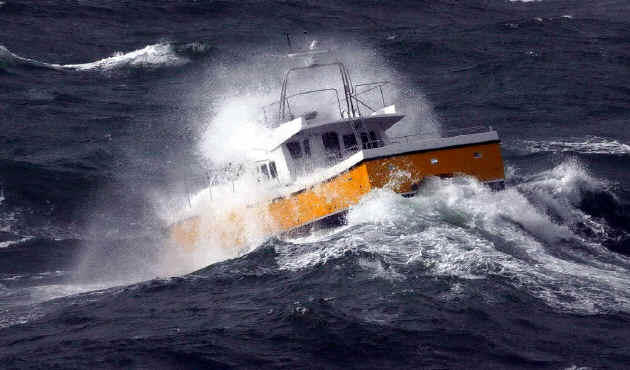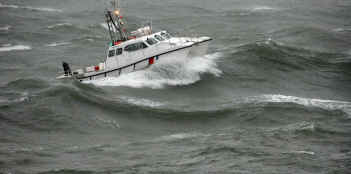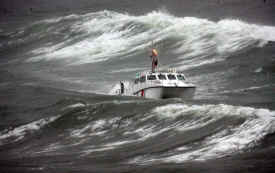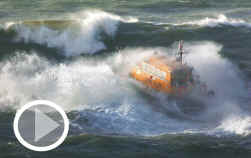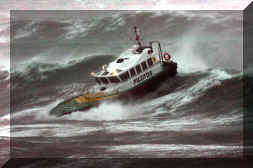| WILDCAT
40 / 12m CATAMARAN Symmetrical hull, high buoyancy bow catamaran offering excellent sea keeping, stability and impressive accommodation and deck space, suitable for Hydrographic survey, Research and a multitude of Work boat operational roles.
|
|||||||||||||||||||||||||
|
SPECIFICATION
L.O.A. Length Moulded BEAM Beam moulded Draft Displacment Lightship Seating capacity Fuel capacity Engines Power output Gearboxes Generator Speed Operational Maximum Certification
WLDCAT 40, Ocean Ranger in force 8 and breaking seas
Rough weather video of La Reunion Wildcat in big waves
WLDCAT 40, Seaflower Rough weather trials, force 7-8 off Cork, Ireland
WLDCAT 40, MISBEHAVIN. Rough weather video, twin boat, force 7-8
WLDCAT 40, BLACK cat. Rough weather trials, force 7-8 off Cork, Ireland
|
40ft / 12m 11.8m 4.9m 4.8m 1.3m
12,000-14,000kg 12 pass / 3 crew 1000 litres Volvo /Cat/Yanmar 250 - 500hp Twin Disc 5126 9kw
16-25kts 30kts+ MCA Bureau Veritas |
The WILDCAT 40 11.7m, high buoyancy, symmetrical hull catamaran is designed to offer a large stable work platform in an attractive, graceful design, combining style and good looks with practical functionality, a rare combination today. With a length overall of 12m / 40ft and a beam of 15ft the vessels hulls have been designed to provide high buoyancy in the fwd sections to prevent slamming on the bridge deck, Full length keels are incorporated, and provide protection to the propellers, The vessels beam has been constrained to a wide 4.7m providing a good compromise between work area, stability, Due to the slender nature of the hulls, in choppy conditions vertical accelerations are much reduced in comparison with mono hulls giving a gentle ride and motion. Probably the greatest benefit of the catamaran hull form over the monohull is its transverse static and dynamic stability. With GM figures typically 3-4 times greater than a similar sized mono hull the operational envelope in rough weather is extended. The Catamaran is able to provide a much more stable work platform at slow speed and at rest than a monohull with greatly reduced rolling and motion. The Wildcat lends itself to surveying roles, under normal survey operations the catamaran has much better directional stability than a monohull resulting in less effort and fatigue for the helmsman, which ultimately improves survey data. The reduced vessel motions in heel and yaw result in accurate data recording as does the ability to site the multi beam surveying sonar equipment almost exactly on the vessels transverse and longditudal centre of gravity.
The Wildcat 40 has a superstructure design that is full width maximizing internal accommodation area, yet providing a large and spacious flush aft deck, with the engines accessed from large opening flush hatches, providing excellent accessibility to the engines for service. The catamaran design has of course very high levels of survivability with 8 individual watertight compartments.
Safehaven Marine have considerable experience in supplying survey vessels and we have developed our own unique Multi beam deployment system. The multi beams transducer is deployed through a moon pool in the aft deck by a hydraulically operated deployment frame that was specially designed and developed by Safehaven Marine. The underwater section of the sonar head mounting is hydro-dynamically efficient being of aeroform shape to minimize turbulence and pressure loadings on the mountings, the sonar head can lowered down to below keel level and be lifted up to above deck by hydraulic rams, the moon pool can then be closed allowing safe storage of the transducer during high speed transits. A second dual beam transducer is fitted in the St/bd hull in a removable module allowing transducer interchange afloat, this is fully faired into the hull minimizing turbulence. The main accommodation typically on a hydrographic vessel incorporates a central helm position with alongside seating for the hydrographical equipment operator / navigator and provides panoramic vision all round with all the electronic navigation and hydrographic displays situated in a large console. A work bench is fitted to the port side of the cabin stretching its full length, all the computers for the hydrograpic equipment are stored in a vertical rack / cabinet fitted at the aft of the cabin. To port is a large dinette seating area with a table between. In the st/bd hull is a large heads compartment which is fully lined in white Formica fitted with an electric toilet and sink. In the port hull f/wd is a full galley with 240v hob, sink, fridge and storage lockers. Onboard electrical power is from a 10kw 240v generator supplying multiple sockets throughout the vessel. Other equipment can include a 1500W electric capstan, Electric 95kgf bow thruster, Electro hydraulic 013T HIAB crane, Dive platform, security alarm system and a full compliment of navigation equipment. The vessel can also fitted with a 24,000btu air conditioning unit with high level outlets in the cabin roof for efficient cooling, The Wildcat is very quiet, only 70db being recorded in the cabin at 15kts, reducing to just 65db at 7kts survey speeds and achieving a 21-23kts maximum speed when powered by twin 260hp engines. Safehaven
Marine have a strong portfolio of dedicated Survey / Research vessels.
Tees Navigator Design features. The benefits of the
catamaran hull form are: Transverse static
stability, less rolling and motion Directional stability
in following sea conditions Lower vertical
accelerations smother motion in choppy head seas Lower power
requirements Greater economical
operational range Deck area Cabin space
Head sea abilities However
previously the biggest disadvantage of the older type of
catamaran hull which featured very fine sections fwd with little reserve
buoyancy, giving a very smooth ride in short sea states but suffering
badly in ocean swell conditions due to slamming on the bridge deck. This
shortcoming has been solved with much fuller fwd sections and much
greater buoyancy, giving the hull the necessary lift to prevent slamming
on the bridge deck, allowing higher speeds to be maintained into larger
ocean swells. Performance Due to the low
resistance of the slender catamaran hulls, performance is excellent,
especially at moderate speeds up to 20kts. Typically, horse power
requirements are lower than in a similar sized mono hull. Furthermore
the flat running angles of the catamaran hulls, with no hump to overcome
means that there is a wide range of economical speeds, incurring no
penalty in fuel consumption at transition speeds often dictated by
weather conditions. Stability
Safehaven Marine, Ashgrove, Cobh, Co Cork, Ireland Phone 00353 86 8054582 Email- info@safehavenmarine.com safehavenmarine@eircom.net
|
All our vessels are build to the highest standards of strength & engineering and are renowned world wide for their exceptional sea keeping abilities. For the best, most extreme, rough weather demonstration videos of our boats, see our amazing selection on you tube.
BEST ROUGH WEATHER ACTION PHOTOS We don't just claim our boats have the best sea keeping abilities, here's the proof |
||||||||||||||||||||||

